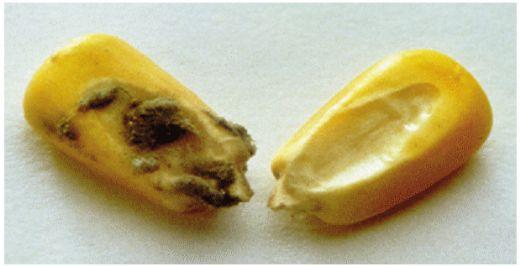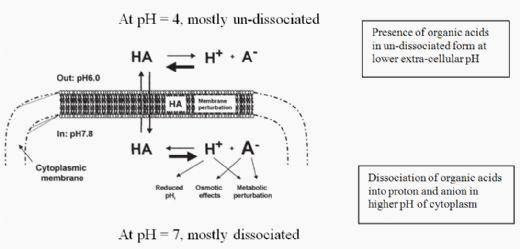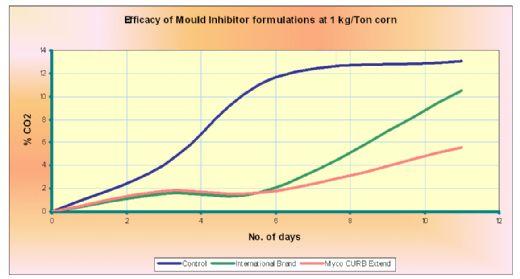Feed and Grain from Mould Contamination
Protection of Feed and Grain from Mould Contamination
Published: October 19, 2010
By: Mr.Josan P.D., Dr. Ng Sek-Yeo
The widespread occurrence of microorganisms in the environment leads to degradation of organic material including grain and feed ingredients. Managing raw materials under adverse climatic conditions is crucial for retaining acceptable feed quality. Grains can develop moulds that produce mycotoxin compounds either prior to harvest or while in storage. High moisture content in grain promotes the development of moulds and mycotoxin production.
An approved anti-mould agent should be generally non-toxic, non-carcinogenic and does not alter the identity of the product being treated. While propionic acid is Generally Recognised As Safe and the use of propionic acid-based mould inhibitors has become widespread in many countries, it is well recognized that feed mill managers may face the corrosive issues associated with the use of certain mould inhibitors.
Corrosion is an oxidation process and is dependent on factors such as moisture, oxygen and pH. Kemin has developed a mould inhibitor product, Myco CURB®brand Extend Liquid, that was designed to have a near neutral pH, a natural colour and a pleasant odour whilst retaining high mould inhibition efficacy. The product contains propionic acid in combination with a plant-based ingredient that did not produce any visible residue when testing for corrosivity.


Figure 1. Untreated corn (left) and corn treated with a mould inhibitor (right).
Antimicrobial Mechanism
Many parameters govern the survival and growth of mould in foods and feeds, one of which is pH. The mechanism of action of organic acids on mould has been attributed to several mechanisms: a simple pH-lowering effect, the perturbation of bacteria cell membrane, the depletion of metabolic energy and the anion effect. The un-dissociated form of organic acids penetrates the cell walls of the mould into the cell interior. In the cell, the organic acids dissociate into the ionic forms: H+ and A- as shown in Figure 2. The pH of the cell decreases dramatically due to the presence of H+ in the cell. In order to maintain homeostasis, the cell will actively pump out the H+ ions, thereby depleting the energy of the cell. The disruption of the permeability of the membrane may cause reduction in cellular uptake of amino acids and nutrients, and together with the anions formed inhibit the synthesis of cell wall components, DNA, RNA, lipids and proteins. These actions of organic acids effectively prevent mould growth.

Figure 2. Mode of action of organic acids.
Besides organic acids, essential oils can also exert synergistic effect in inhibiting mould growth. This is ascribed to the ability of the essential oils to weaken the microbial cell wall, thereby increasing the permeability of the cell wall to organic acids.
Mould Inhibitor Formulations
An ideal mould inhibitor product should contain high propionic acid content with low corrosion property and this is a challenge to the industry. Myco CURB Extend Liquid is an effective mould inhibitor that contains high propionic acid content, an essential oil and an antioxidant. The essential oil and antioxidant also help to prevent corrosion.
Carbon Dioxide Test
Moulds in feed respire and respiration produces carbon dioxide according to the chemical equation: C6H12O6 + 6O2 6CO2 + 6H2O. The carbon dioxide evolved can be measured to determine the efficacy of mould inhibitors as more carbon dioxide production indicates more mould growth. Figure 3 shows the results of a carbon dioxide test performed using Myco CURB Extend Liquid.
Moulds in feed respire and respiration produces carbon dioxide according to the chemical equation: C6H12O6 + 6O2 6CO2 + 6H2O. The carbon dioxide evolved can be measured to determine the efficacy of mould inhibitors as more carbon dioxide production indicates more mould growth. Figure 3 shows the results of a carbon dioxide test performed using Myco CURB Extend Liquid.
The results show that corn treated with Myco CURB Extend Liquid evolved less carbon dioxide indicating that Myco CURB Extend Liquid is a more effective mould inhibitor.
Corrosion Test. The corrosiveness of mould inhibitor products can be tested by partial or full immersion of metals into the products. The partial immersion method is a quantitative method. This method measures the weight loss from a metal plate after partially immersing it in products for 11 days at 65ºC. High weight loss indicates a higher corrosive formulation. Figure 4 shows the pictures of the test samples after the test period.


Figure 3. Carbon dioxide production over time for untreated corn and corn treated with mould inhibitors
The results show that corn treated with Myco CURB Extend Liquid evolved less carbon dioxide indicating that Myco CURB Extend Liquid is a more effective mould inhibitor.
Corrosion Test. The corrosiveness of mould inhibitor products can be tested by partial or full immersion of metals into the products. The partial immersion method is a quantitative method. This method measures the weight loss from a metal plate after partially immersing it in products for 11 days at 65ºC. High weight loss indicates a higher corrosive formulation. Figure 4 shows the pictures of the test samples after the test period.
 |  |
Figure 4. Evidence of corrosivity of an international brand mould inhibitor (MI) is shown by the corroded metal residue that clouds the MI solution in the test bottle (a). In contrast, Myco CURB Extend Liquid produces a clear solution when a similar metal strip is immersed in it (b).
Corrosion is an oxidation process where the metal ion combines with oxygen from the surrounding environment to form the metallic oxide. The factors affecting the corrosion process are the pH of the medium, the presence of water and oxygen. Therefore, the corrosion process may be controlled by adjusting the pH of the medium and also by quenching the available oxygen from the system. The corrosion process rate is minimal at near neutral pH. Myco CURB Extend Liquid is formulated to a near neutral pH. An antioxidant ingredient derived from a plant source has also been included in the product, which further reduces the corrosion process.
Surface Tension. The surface tension of a liquid determines its degree of spreadability over a solid. Liquids with less surface tension are expected to spread more evenly over a solid particle. The comparison of mould inhibitors for this spreadability can be done by diluting them in water and measuring the reduction in the water surface tension. Lower water surface tension is an indication of better dispersion and spreading of the mould inhibitor over the grain. From Figure 5 it can be seen that addition of Myco CURB Extend Liquid reduced the surface tension of the aqueous solution. Myco CURB Extend Liquid can spread effectively over grain and feed to enhance protection against mould growth.


Figure 5. Surface Tension of Water with Mould Inhibitor Formulations
Conclusions
Myco CURB Extend Liquid is a novel patented mould inhibitor from Kemin. In addition to its effective mould-inhibiting effects the product also contains a plant extract with antioxidant and anti-microbial properties. With its prolonged action and better spreadability on grain and feed for effective mould inhibition, Myco CURB Extend Liquid has the added benefit of corrosion protection.
Related topics:
Authors:
Kemin Industries, Inc
Recommend
Comment
Share
28 de junio de 2011
Dear all Participants,
My questions are till non answerable. If anybody have more idea about short chain fatty acids please update the same in discussion forum viz. different short chain fatty acids with their role in animal nutrition.
regards,
Dr Jaydip
Recommend
Reply
28 de junio de 2011
can this product be use in feed pellet mill? i have a problem in farm, with broillers and i supose the cause is micotoxines. some broiller are growing and ather have problem with legs articulations. i use veratox kits and the values of micotoxines are different to sample to sample. what may be the problem?
Recommend
Reply
1 de abril de 2011
Excellent article and information about the product is well depicted. I would like to know how this product to be used to prevent mouldiness in beer waste. can we prescribe this product for direct use for farmers?If so, kindly let me know th e dosage to be used
Regards
Dr.Deepa ananth
Recommend
Reply
11 de noviembre de 2010
a very good information for the people engaged in storage of grains &feed manufactures who are required to keep large stocks of corn where mould is one of the major problems in spoilage of grains,definitely mycocurb will enhance the quality of finished feed.thank you for this new product.
Recommend
Reply
19 de octubre de 2010
A very good article. Product explanation with regard to its action against moulds is excellent. But at the same time, organic acids are also improve digestions, this is additional benefit when you use product like MycoCurb.
Recommend
Reply
19 de octubre de 2010
Dear Sir,
We always salute to the innovations made by Kemin in the field of Animal nutrition.
This innovative mould inhibitor will definitely resolves the past issues related to use
of such products.
If i am correct propionic acid is a short chain fatty acid with aliphatic tails of less than
six carbons.& in Lipid digestion that directly absorbed in portal vein.If so then this
group contains other fatty acids than Propionic acid, apart from that also why
propionic acid is prefered as mould inhibitor?
{Acetic acid , Propionic acid ,Isobutyric acid (2-methylpropanoic acid) ,Butyric acid ,Isovaleric acid (3-methylbutanoic acid) ,Valeric acid (pentanoic acid) ,Caproic acid (hexanoic acid)}
Please your kindly guidence on the topic will help me to upgrade my knowledge on
the subject matter.
Wishing the better success for your this product in the Indian Market.
Thanks & regards,
Dr. Jaydip
Recommend
Reply
Kemin Industries, Inc
19 de octubre de 2010
Excellent aticle. Pictures shown about corrosiveness of mould inhibitors is very interesting. This shows the importance of developing technology in the safety front to bring wonderful formulation
Recommend
Reply

Would you like to discuss another topic? Create a new post to engage with experts in the community.











.jpg&w=3840&q=75)